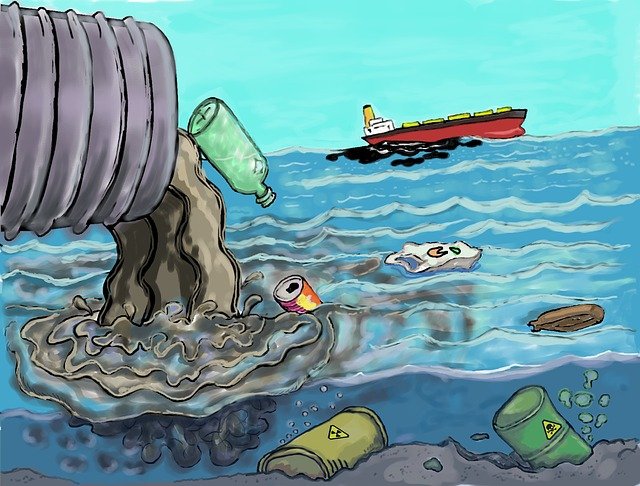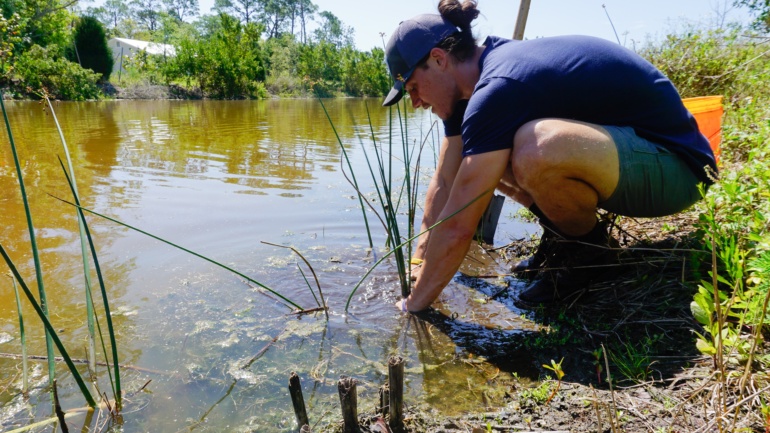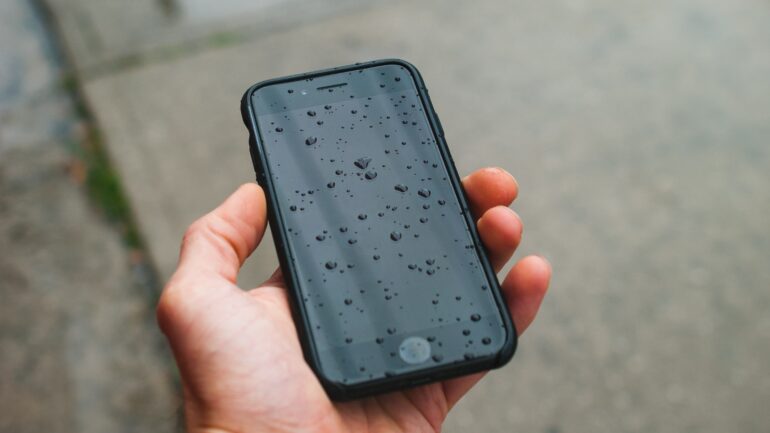Written by April Day, Staff Writer for Save The Water™ | January 5th, 2018
After the Storms, Contaminated Runoff Can Still Threaten Human Health
The 2017 Atlantic hurricane season wreaked chaos, pummeling the United States with Hurricane Harvey, Hurricane Irma, and Hurricane Maria.1 After Hurricane Harvey devastated and killed people, it continued to threaten human health with flooding that both natural waterways and stormwater management systems, such as Houston’s, couldn’t handle.2 In short, a stormwater system can be overtaxed, leading to waters with various chemicals coming into direct contact with people and emptying into larger drinking water sources, untreated. Among other chemicals, pesticides could be in the untreated runoff since they are used pervasively. Moreover, pesticides have also been linked to certain cancers, allergies, neurological disorders, and endocrine disruption.3 To be sure, endocrine disruptors, as the name suggests, threaten human health by disrupting natural functions.
Pesticides and Other Endocrine Disruptors Can Contaminate Drinking Water
Between 1961 and 2004, the amount of pesticides used worldwide increased over fivefold.3 Later, by 2010, in the United States alone, pesticide use tipped the scales at over 1 billion pounds annually. Comparatively, worldwide, that number jumps to 5.6 billion. Because measures to limit exposure are limited or imperfect, worldwide, as many as 25 million agricultural workers experience unintentional pesticide poisonings each year. For example, in the United States, one prospective study estimated that 16 percent of pesticide users “had at least one pesticide poisoning or an unusually high pesticide exposure episode in their lifetime.”4 Furthermore, the World Health Organization has estimated that pesticide poisoning results in about 220,000 deaths each year.3
To illustrate, the United States Environmental Protection Agency (US EPA) regulates pesticides under the Federal Insecticide, Fungicide, and Rodenticide Act.5 In short, the Safe Drinking Water Act makes the US EPA responsible for setting standards for drinking water quality.6 Specifically, the US EPA acknowledges that pesticides “have the potential to contaminate drinking water supplies.”7
In brief, pesticides can take many pathways to get into drinking water supplies.8 Some of the pathways include
- Drainage through groundwater
- Surface runoff8 (which are flows of water from heavy storms, snow melts, or other sources that flow over land)9
- Aerial drifts or spills8
Additionally, the U.S. Department of Agriculture has estimated that about 50 million people in the United States get their drinking water “from groundwater that is potentially contaminated by pesticides and other agricultural chemicals.”4 To put it another way, pesticides account for many of the chemicals identified as endocrine disruptors.3 By 2011, 105 substances had been identified.3 Although governments banned some of the chemicals years ago, like DDT, they persist in the environment.3
Health Problems and Endocrine Disruptors
In sum, endocrine disruptors trick the body by mimicking natural hormones and blocking hormone receptors. That is to say, the endocrine disruptors interfere with how the body works, including human reproduction, growth, and development.3 Also, endocrine disruptors can “interfere with the synthesis, transport, metabolism and elimination of hormones, thereby decreasing the concentration of natural hormones.”3
Above all, children, infants, and fetuses are particularly vulnerable to endocrine disruptors.3 Despite this, harms caused to the fetus may not be apparent until adulthood.3 For example, for infants, harms include possible long-term intellectual function, and delayed effects on the central nervous system.3
At the same time, endocrine disruptors have also been linked to infertility.3 For instance, a study concluded that exposure to pesticides “may affect spermatogenesis leading to poor semen quality and reduced male fertility.”3 Similarly, the results of studies have linked environmental exposure to pesticides to certain cancers, including breast cancer.3 According to epidemiological studies in Spain between 1999 and 2009, of women with breast cancer, 81 percent were observed in geographic areas with high levels of pesticide contamination.3 In addition, pesticide exposure may be connected to prostate cancer.3
Coupled with these results, humans are biologically complex creatures. The direct impact of endocrine disruptors is more easily observable in species like fish. One study observed changes in the sex-ratio of fish populations off the coast of California based on the amount of endocrine disruptors in the water.10 The study observed that endocrine disrupting chemicals caused “population decline in fishes.”10 Several endocrine disrupting chemicals have been shown potentially to cause obesity.11 In mice, exposure to endocrine disruptors have also been shown to impair parental relations and adversely reduce maternal parental investment in baby mice.12
Varied Solutions to the Multifaceted Problem
Several solutions address different aspects of the complex problem that endocrine disrupting pesticides cause when they end up in drinking water sources. First, one solution is to substitute natural pesticides for synthetic pesticides. Although there are natural alternatives, some assert that these natural pesticides do not control pests. Moreover, they still interfere adversely with human hormones.3
Second, another solution is to invest in water infrastructure, including better stormwater capture and treatment. Current regulations do not require screening for all endocrine disruptors in drinking water, but the US EPA does regulate pesticides.2 Further investigation to expand the number of endocrine disruptors tested and to lower the acceptable levels of pesticides in drinking water is another approach.13
What’s more, a third solution is to better monitor the quality of critical drinking water sources such as the Florida Everglades. Without a doubt, monitoring water is critical for determining how to treat water that receives unexpected amounts of stormwater.
Last, a fourth solution is to use and to invest in technology that treat endocrine disruptors in water. For instance, some treatment processes have already been identified, such as ozonation and pre-oxidation.14
Action
We at Save the Water™ are dedicated to safe, contamination-free water for all. We will continue to pursue opportunities to achieve that goal by monitoring and testing water by using scientifically sound methods. We invite you to learn more about how you can help by looking at different parts of our website.
References
- CNN. Last updated Oct. 30, 2017. “2017 Atlantic Hurricane Season Fast Facts.”
http://edition.cnn.com/2017/05/15/us/2017-atlantic-hurricane-season-fast-facts/index.html - Roger K. Lewis. August 31, 2017. “Houston’s topography and ability to handle stormwater play a role in flooding.” The Washington Post.
https://www.washingtonpost.com/realestate/houstons-topography-and-ability-to-handle-stormwater-play-a-role-in-flooding/2017/08/31/9ef51b06-8d97-11e7-84c0-02cc069f2c37_story.html?utm_term=.13afcf1355f9 - Wissem Mnif et al. June 2011. “Effect of Endocrine Disruptor Pesticides: A Review.” International Journal of Environmental Research and Public Health 8(6). https://www.ncbi.nlm.nih.gov/pmc/articles/PMC3138025/
- Michael C.R. Alavanja.Oct.-Dec. 2009. “Pesticides Use and Exposure Extensive Worldwide.” Reviews on Environmental Health 24(4). https://www.ncbi.nlm.nih.gov/pmc/articles/PMC2946087/
- U.S. Environmental Protection Agency. “Basic Information about Pesticide Ingredients.” https://www.epa.gov/ingredients-used-pesticide-products/basic-information-about-pesticide-ingredients
- U.S. Environmental Protection Agency. “Safe Drinking Water Act (SDWA).” https://www.epa.gov/sdwa
- U.S. Environmental Protection Agency. “Drinking Water and Pesticides.” https://www.epa.gov/safepestcontrol/drinking-water-and-pesticides
- Mike Stewart et al. 2017. Literature Review of the risks and adverse effects from discharges of stormwater, wastewater, industrial and trade waste, and other hazardous substances in Otago. Streamlined Ltd. https://www.orc.govt.nz/media/3745/literature-review.pdf
- ScienceDaily. Reference Terms: Surface runoff.
https://www.sciencedaily.com/terms/surface_runoff.htm - Susanne M. Brander et al. 2013. “From ‘Omics to Otoliths: Responses of an Estuarine Fish to Endocrine Disrupting Compounds across Biological Scales.” PLoS ONE 8(9).
http://journals.plos.org/plosone/article?id=10.1371/journal.pone.0074251 - Anna Pereira-Fernandes et al. 2013. Evaluation of a Screening System for Obesogenic Compounds: Screening of Endocrine Disrupting Compounds and Evaluation of the PPAR Dependency of the Effect. PLoS ONE 8(10). http://journals.plos.org/plosone/article?id=10.1371/journal.pone.0077481
- Sarah A. Johnson. 2015. “Disruption of Parenting Behaviors in California Mice, a Monogamous Rodent Species, by Endocrine Disrupting Chemicals.” PLoS ONE 10(6).
http://journals.plos.org/plosone/article?id=10.1371/journal.pone.0126284 - Cornelius B. Murphy, Jr. April 15, 2014. “Endocrine Disruptors: Latest Threat to Surface Waters.” https://www.huffingtonpost.com/cornelius-b-murphy-jr-phd/endocrine-disruptors-late_b_4696440.html
- Xuemen Lv. 2016. “Occurrence and removal of phenolic endocrine disrupting chemicals in the water treatment processes.” Scientific Reports 6: 22860. Rep.https://www.ncbi.nlm.nih.gov/pmc/articles/PMC4782170/




